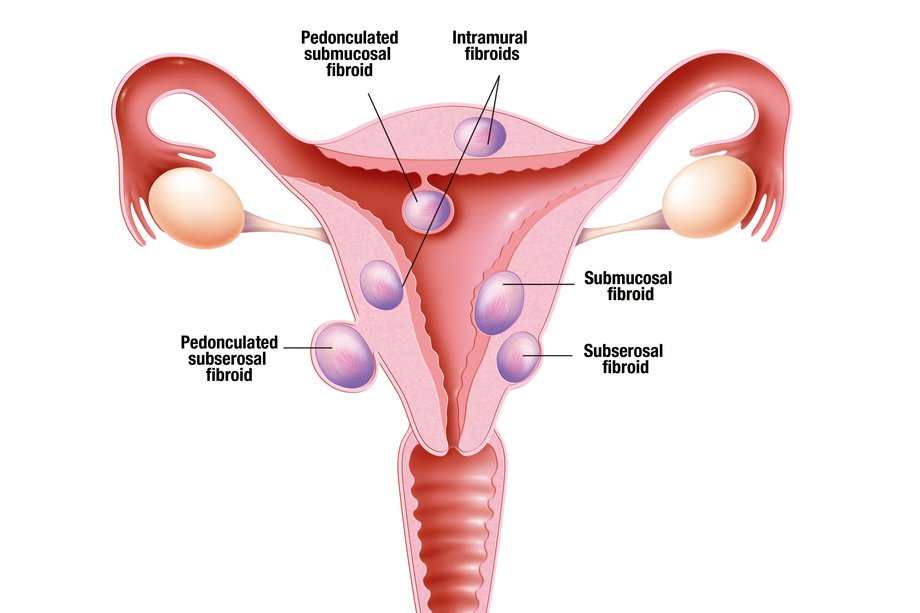Non-cancerous growths in the uterus that can develop during a woman’s childbearing years. The cause of fibroid isn’t well understood. Risk factors include a family history of fibroid, obesity or early onset of puberty. Symptoms include heavy menstrual bleeding, prolonged periods and pelvic pain. In some cases, there are no symptoms.
Fibroids are common, with around 1 in 3 women developing them at some point in their life. They most often occur in women aged 30 to 50. It’s also thought they occur more often in overweight or obese women because being overweight increases the level of estrogen in the body.
Types of fibroids
Fibroids can grow anywhere in the womb and vary in size considerably. Some can be the size of a pea, whereas others can be the size of a melon. The main types of fibroids are:
- Intramural fibroids – the most common type of fibroid, which develops in the muscle wall of the womb
- Subserosal fibroids – fibroids that develop outside the wall of the womb into the pelvis and can become very large
- Submucosal fibroids – fibroids that develop in the muscle layer beneath the womb’s inner lining and grow into the cavity of the womb
In some cases, subserosal or submucosal fibroids are attached to the womb with a narrow stalk of tissue. These are known as pedunculated fibroids.
Symptoms
The most common symptoms of uterine fibroids include:
- Heavy, prolonged, or painful periods
- Pain in the lower abdomen or back
- Painful sex
- Frequent Urination
- Discomfort in the rectum
FAQ about Fibroids
Sometimes patients have some questions and myths in their mind so we try to answer some of them below.
Fibroids, also known as uterine leiomyomas, are non-cancerous tumours coming from the myometrium (the muscle layer) of the uterus. Fibroids are extremely common. Up to four out of every five women have fibroids, although most of these women have no symptoms and do not need any treatment. Fibroids cause symptoms in approximately one out of every four women of reproductive age. They are usually detected in women in their thirties and forties and are more common in black women than white women. Fibroids usually shrink after menopause.
There are many different types of fibroids. Depending on their size and location, fibroids can present with a wide range of symptoms. Fibroids can be divided into submucosal, intramural or subserosal.
Submucosal fibroids These fibroids are located just underneath the endometrium, or lining of the uterus, and protrude into the uterine cavity. They often cause heavy bleeding and long periods, but they can also cause irregular bleeding.
Intramural fibroids These fibroids are found predominantly in the myometrium, or muscle of the uterus. Depending on their size and location, these fibroids can also extend toward and distort the uterine cavity or protrude outside the uterus. Intramural fibroids can be asymptomatic (causing no symptoms), cause bleeding abnormalities, or cause pressure and bulk symptoms.
Subserosal fibroids These fibroids are located near the outside of the uterus. They can be partially in the myometrium (muscle of the uterus) or hanging off the outside of the uterus. They can cause bulk symptoms such as bladder or rectal pressure.
hanges in menstruation
- Longer, more frequent, or heavy menstrual periods
- Menstrual pain (cramps)
- Vaginal bleeding at times other than menstruation
- Anemia (from blood loss)
Pain
- In the abdomen or lower back (often dull, heavy and aching, but may be sharp)
- During sex
Pressure
- Difficulty urinating or frequent urination
- Constipation, rectal pain, or difficult bowel movements
- Abdominal cramps
- Enlarged uterus and abdomen
- Miscarriages
- Infertility Fibroids also may cause no symptoms at all. Fibroids may be found during a routine pelvic exam or during tests for other problems. For further details on treatment options ...Consult your Doctor
